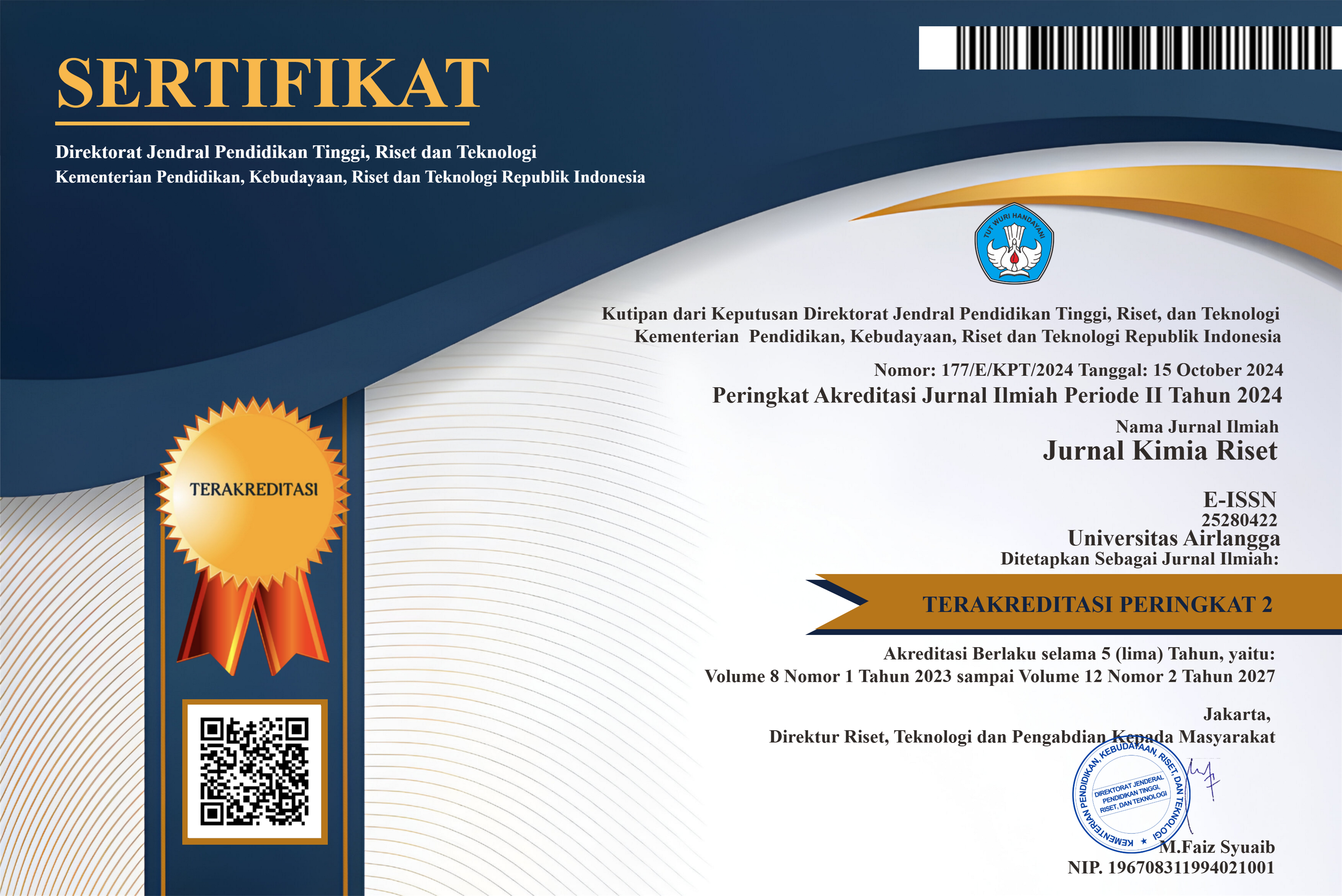THE UTILIZATION OF BLOTONG, MOLASSES, BRAN, AND COCONUT HUSK INTO COMPOST USING MOL OF STALE RICE AND Trichoderma sp.
Downloads
Compost is a solution for dealing with organic waste. Compost with organic material must be mixed according to its elemental composition. Protein and potassium are obtained from bran and coconut husk. Blotong contains phosphorus (P), while molasses contains total N and K2O. Local Microorganisms (MOL) of stale rice is an activator to increase the microbiological decomposition of organic matter and contains Saccharomyces cerevisiae, Bacillus cereus, and Aspergillus sp. The addition of Trichoderma sp. can speed up the composting process. The aim of the study is to determine the effect of adding Blotong and bran on the quality of compost, to obtain the most effective composition of Blotong, molasses, bran, and coconut husk for composting using MOL activator of stale rice and Trichoderma sp. according to SNI 7763:2018, and to determine the most effective composting time. The ratio of Blotong, coconut husk, bran, and molasses for the three variations were 56:10:30:4; 66:10:20:4; and 76:10:10:4 in percent as much as 6 kg calculated with Takakura method. The result of the study showed the three variations had fulfilled SNI 7763:2018 in 18 days, with the most effective composition is the 3rd variation.
Afifah, A.S., Prajati, G., & Surawan, I.W., 2019, Pengaruh Waktu Pengomposan dan Komposisi Kompos Sampah Organik terhadap Laju Pertumbuhan Daun Tanaman Kacang Panjang (Vigna Cylindrica), Jurnal Rekayasa Sipil dan Lingkungan, ISSN 2548-9518, 3(1), 1-7.
Amanah, Farisatul., 2012, Pengaruh Pengadukan dan Komposisi Bahan Kompos terhadap Kualitas Kompos Campuran Lumpur Tinja, Skripsi, Fakultas Teknik Universitas Indonesia, Depok.
Ardiansyah, 2019, Kualitas Kimia Kompos Limbah Organik Pasar dengan Jenis Bioaktivator yang Berbeda, Skripsi, Universitas Islam Negeri Sultan Syarif Kasim Riau.
Balai Penelitian dan Pengembangan Pertanian Kementrian Pertanian, 2015, Kegunaan unsur-unsur hara bagi tanaman, https://sulut.litbang.pertanian.go.id/ind/index.php?option=com_content&view=article&id=582&Itemid=65, Diakses pada 27 Juni 2021, dari
Dharma, P.A., Suwastika, A.A., & Sutari, N.W, 2018, Kajian Pemanfaatan Limbah Sabut Kelapa Menjadi Larutan Mikroorganisme Lokal, Jurnal Aroteknologi Tropika, 7(2), 200-2010.
Emadian, S.M., Onay, T.T., & Demirel, B., 2017, Biodegradation of bioplastics in natural environments, Waste Manag, 59, 526–536
Rina, D., 2015, Manfaat Unsur N, P, dan K Bagi Tanaman, Jurnal Penelitian dan Pengembangan Pertanian.
Faridah, A., Sumiyanti, S., & Handayani, D. A., 2013, Studi Perbandingan Pengaruh Penambahan Aktivator Agri Simba dengan MOL Bonggol Pisang terhadap Kandungan Unsur Hara Makro (CNPK) Kompos dari Blotong (Sugarcane Filter Cake) dengan Variasi Penambahan Kulit Kopi, Jurnal Teknik Lingkungan, 1, 1-9.
Fangohoy, L. dan Wandansari, N. R., 2017, Pemanfaatan Limbah Blotong Pengolahan Tebu Menjadi Pupuk Organik Berkualitas, Jurnal Triton, 8(2), 58-66.
Fanny, Ali. M., & Mirwan, M., 2013, Pemanfaatan Blotong sebagai Aktivator Pupuk Organik, Jurnal Ilmiah Teknik Lingkungan, 5(2), 116-123.
Gaur, D. C., 1983, Present Status of Composting and Agricultural Aspect, in: Hesse, P. R. (ed). Improving Soil Fertility Through Organic Recycling, Compost Technology, New Delhi: FAO of United Nation.
Indrasti, N. S & Wimbano, O., 2006, Campuran Jerami dan Ampas Batang Sagu dengan Kotoran Sapi, Jurnal Teknik Industri, 16(2), 51-90.
Indrawan, Widawan, & Oviantari, 2016, Analisis Kadar N, P, K dalam Pupuk Kompos Produksi TPA Jagaraga, Buleleng, Jurnal Wahana Matematika dan Sains, 9(2), 25-31.
Indriani, Y. H., 2007, Membuat Pupuk Organik Secara Singkat, Jakarta: Penebar Swadaya.
Irawan, Diah S., dan Sri. R., 2012, Proyeksi Kebutuhan Pupuk Sektor Pertanian Melalui Pendekatan Sistem Dinamis, Jurnal Peneliti Badan Litbang Pertanian, 123-139.
Juradi, M. A., 2020, Inovasi Teknologi Penerapan Kompos Blotong untuk Perbaikan Kesuburan Tanah dan Peningkatan Produktivitas Tanaman Tebu, Jurnal Agrotek, 4(1), 24-36.
Krisnawan, K.A., Tika, I.W., Madrini, I.A, 2018, Analisis Dinamika Suhu pada Proses Pengomposan Jerami Dicampur Kotoran Ayam dengan Perlakuan Kadar Air, Jurnal Biosistem dan Teknik Pertanian, 6(1), 25-32.
Kojo, R. M., Rustandi, Y. R. L., Tulung, & S. S., Malalantang, 2015, Pengaruh Penambahan Dedak Padi dan Tepung Jagung terhadap Kualitas Fisik Silase Rumput Gajah, Jurnal zootek, 35(1), 21-29.
Kusuma, 2012, Pengaruh Variasi Kadar Air terhadap Laju Dekomposisi Kompos Sampah Organik di Kota Depok, Tesis, Fakultas Teknik Universitas Indonesia, Depok.
Liandari, N. P., 2017, Pengaruh Bioaktivator EM-4 Dan Aditif Tetes Tebu (Molasses) Terhadap Kandungan N, P Dan K Dalam Pembuatan Pupuk Organik Cair Dari Limbah Cair Tahu, Skripsi, Universitas Muhammadiyah Surakarta.
Ma, Qianqian, Yanli, L., Jianming, X., Dengmiao, C., & Zhaojun, L., 2022, Effects of Turning Frequency on Ammonia Emission during the Composting of Chicken Manure and Soybean Straw, Journal Molecules, 1-21.
Pambudi, D., Maulana, I., & Soemarno, S., 2017, Pengaruh Blotong, Abu Ketel, Kompos terhadap Ketersediaan Fosfor Tanah dan Pertumbuhan Tebu Di Lahan Tebu Pabrik Gula Kebon Agung, Malang, Jurnal Tanah dan Sumberdaya Lahan, 4(1), 431-443.
Pandebesie, E. S., & Rayuanti, D., 2013, Pengaruh Penambahan Sekam pada Proses Pengomposan Sampah Domestik, Jurnal Lingkungan Tropis, 6(1), 31-40.
Purnomo, E. D., Sustsno, E., Sumiyati, S., 2017, Pengaruh Variasi C/N Rasio Terhadap Produksi Kompos dan Kandungan Kalium (K), Pospat (P) dari Batang Pisang Dengan Kombinasi Kotoran Sapi dalam Sistem Vermicomposting, Jurnal Teknik Lingkungan, 6(2), 1-15.
Saraswati, R., Santosa, E., & Yuniarti, E., 2006, Organisme Perombak Bahan Organik, Pupuk Organik dan Pupuk Hayati, 211-230.
Sayara, Tahseen & Antoni, Sanchez, 2021, Gaseous Emissions from the Composting Process: Controlling Parameters and Strategies of Mitigation, Journal MDPI.
Sekarsari, N., 2011, Pengaruh Frekuensi Pengadukan Terhadap Proses Pengomposan Open Windrow (Studi Kasus: UPS Jalan Jawa, Kota Depok), Depok: Universitas Indonesia.
Setyorini, D., 2005, Pupuk Organik Tingkatkan Produksi Tanaman, Warta Penelitian dan Pengembanagn Pertanian, 27, 13 – 15.
Setyorini, D., Saraswati, R., & Anwar, E.K., 2006, Kompos, Pupuk Organik dan Pupuk Hayati, 1-281.
Sianturi, Andry H., Hutagaol, I. P. R. H., Trisakri, B., & Irvan, 2019, Pembuatan Kompos dari Campuran 60% Berat Tandan Kosong Kelapa Sawit dan 40% Berat Azolla Microphylla, Jurnal Penelitian, 8(1), 6-10.
Siregar, R. W., 2017, Pengaruh Frekuensi Pengadukan pada Proses Pembuatan Pupuk Organik Padat dari Campuran Blotong, Kulit Pisang, dan Molase dengan Metode Pengomposan Menggunakan Aktivator Effective Mikroorganism-4 (EM-4), Skripsi, Universitas Sumatera Utara.
Sormin, E. S., 2017, Pengaruh Variasi Komposisi Blotong dan Kulit Pisang dalam Pembuatan Pupuk Organik Padat dari Campuran Blotong, Kulit Pisang, dan Molase Menggunakan Aktivator Effective Mikroorganisme-4 (EM-4), Skripsi, Universitas Sumatera Utara.
Suriani, Sanita, Soemarno, & Suharjo, 2013), Pengaruh Suhu dan pH terhadap Laju Pertumbuhan Lima Isolat Bakteri Anggota Genus Pseudomonas yang Diisolasi dari Ekosistem Sungai Tercemar Deterjen di Sekitar Kampus Universitas Brawijaya, Jurnal-PAL, 3(2), 58-62.
Wahyuningsih, N., & Zulaika, E., 2018, Perbandingan Pertumbuhan Bakteri Selulolitik pada Media Nutrient Broth dan Carboxy Methyl Cellulose, Jurnal Sains dan Seni ITS, 7(2), 36-38.
Widarti, B.N., Wardhini, W.K., & Sarwono, E., 2015, Pengaruh Rasio C/N Bahan Baku pada Pembuatan Kompos dari Kubis dan Kulit Pisang, Jurnal Integrasi Proses, 5(2), 75-80.
Wizna dan Muis, H., 2012, Pemberian Dedak Padi yang Difermentasi dengan Bacillus amyloliquefaciens sebagai Pengganti Ransum Komersil Ayam Ras Petelur; Jurnal Peternakan Indonesia, 14(2), 398-403.
Woodford, Philip Bernard, 2009, In-Vessel Composting Model with Multiple Substrate and Microorganism Types, Dissertation,Kansas State University.
Copyright (c) 2022 Jurnal Kimia Riset

This work is licensed under a Creative Commons Attribution-NonCommercial-ShareAlike 4.0 International License.
COPYRIGHT NOTICE
1. By submitting the article to Jurnal Kimia Riset (JKR), the author has agreed to transfer some of the copyrights to the publisher of the research chemistry journal, Universitas Airlangga, indicated in the Copyright Transfer Agreement.
2. Authors still retain significant rights to use and share their own published articles for non-commercial purposes subject to Creative Commons Attribution-NonComercial 4.0 International License
3. All publications (printed/electronic) are open access for educational purposes, research, library, and other non-commercial purposes. Besides the purposes mentioned above, the editorial board is not responsible for copyright violations.















